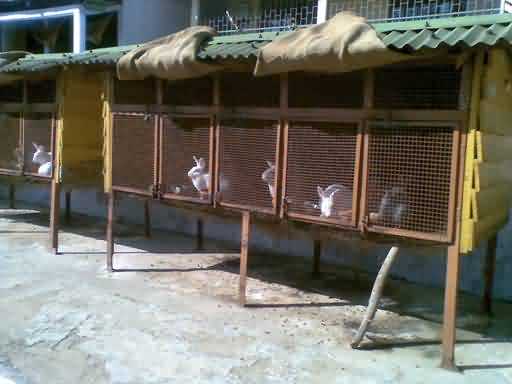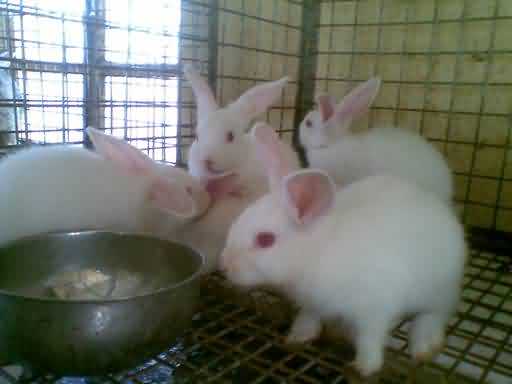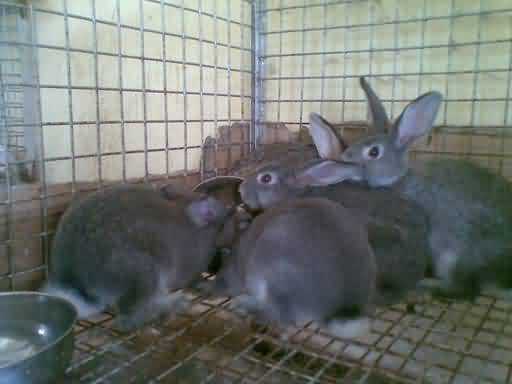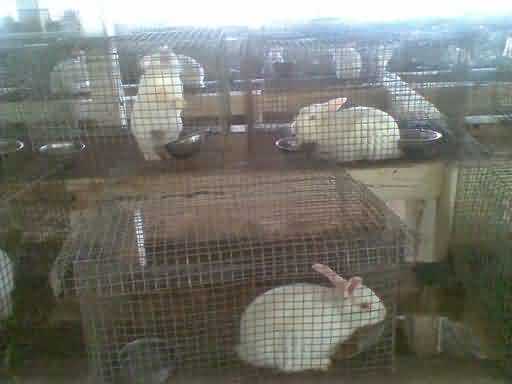ब्रॉयलर खरगोश का उत्पादन और प्रबंधन
The feed habits of Indian are changing with increased consumption of animal protein, especially meet on account of the improving living standard. Conventional meat produces like sheep, goat, cattle, pig and poultry will not be able to meet this demand. Considering the heavy demand of meat and meat products farming of broiler rabbit in India has tremendous scope as an alternative source of meat.
Advantages with rabbit meat
Rabbit meat is almost cholesterol free (50mg/ 100 gm) and contains least fat among the all available meat. Hence, the heart patient also can consume rabbit meat. It is a white lean meat; very tender, juicy and delicious meat.
Calcium and phosphorous content is more i.e. 20 mg/ 100 gm and 350mg/ 100gm of meat, respectively and less sodium content (40mg/ 100 gm meat). High amount of poly unsaturated fatty acid which are of detrimental to heart.
Rabbit meat has less caloric value and highest nicotinic acid (13mg/ kg meat) containing meat, high percentage of easily digestible protein and nutritive value. Dressing percentage is 60 to 65% and bone- meat ratio is 5: 1.2.
Rabbit meat does not have strong flavour, high palatability, easily digestible and suitable for consumption in both hot and cold climatic condition. There is no taboo or social stigma attached to the consumption of this meat.
Comparative nutritive values of rabbit meat
|
Animal |
Meat |
Calorie/ 100gm |
Moisture % |
Protein % |
Fat % |
Cholesterol % |
Calcium mg/100gm |
Phosphorus mg/100gm |
Sodium mg/100gm |
|
Rabbit |
Game |
795 |
67.9 |
20.8 |
11.2 |
50 |
20 |
350 |
40 |
|
Poultry |
Chicken |
810 |
67.6 |
20.0 |
11.0 |
60 |
10 |
240 |
70 |
|
Goat |
Chevon |
1090 |
60.0 |
15.0 |
15.0 |
90 |
10 |
165 |
75 |
|
Sheep |
Mutton |
1420 |
55.8 |
15.7 |
27.7 |
66 |
7 |
190 |
88 |
|
Cattle |
Beef |
1440 |
55.0 |
16.3 |
28.0 |
105 |
12 |
195 |
65 |
|
Pig |
Pork |
2050 |
42.0 |
11.9 |
45.0 |
110 |
10 |
195 |
70 |
Why to go for rabbit farming?
- Rabbit is relatively a new introduction as a micro livestock in our country.
- Nowadays rabbit farming is gaining momentum for meat, fur skin and meat production in the country.
- Easy to maintain- due to small body size of the broiler rabbit, require less space for accommodation and feeding.
- It can be raised on roughage diet solely without affecting productive and reproductive performance.
- Rabbit does not compete with human beings for food grains like pig and poultry.
- A small unit of rabbit can be successfully raised in the backyard with vegetable or kitchen waste, green fodders and tree leaves.
- Its reproductive potential is very high and short generation interval. Being an induced ovulator, rabbit can be bred within 24 hours of kindling.
- Rabbit can be bred all round the year and gives at least four crops in a year with five litters per crop i. e. 20 kits/ doe/ year.
- Rabbit is fast multiplier, matures within 5 to 7 months time and gestation period is only 30 days.
- It is adaptable in wide range of climatic conditions i.e. hot humid to cold weather.
- Growth rate is very fast. The broiler rabbit can attain body weight of 1.5 to 2.0 kg in 90 days and can be marketed for slaughtering.
- Comparatively resistant to diseases than the other animals and poultry birds. There are few incidences of infectious diseases and worm infestations in rabbit except few protozoan (coccidian etc) and parasitic diseases. No vaccination required.
- Apart from meat rabbit also produces fur skin and pelt as by-product which can be utilized for preparation of fancy items like caps, hand gloves, purse, children jackets etc.
- Rabbit fit very well in integrated farming system and can be reared in the backyard with limited space.
- The rabbit farming does not require huge investment like other livestock enterprises. The maintenance requirement for raising rabbits is very meager.
- Rabbit husbandry can generate great potential for hundreds of jobless youth and woman folk of the country. Even small scale backyard rabbit keeping can substantially increase income of the household.
Management of rabbit farming
To explore the optimum production of rabbits for meat and overall profitability of the rabbit farm the animal should be managed with modern scientific know-how. The important management practices include selection of breed, housing, feeding, breeding and health management of rabbit.
Selection of breed for broiler rabbit farming
Choosing the right breed is very important for successful farming of broiler rabbit. There are approximately 89 internationally recognized breed of rabbit. The important breed that can be selected for successful rabbit farming in India are Soviet Chinchilla, Newzealand White, Grey Giant, White Giant, Flemish Giant, Californian, Silver Fox etc.
Newzealand White rabbit Soviet Chinchilla rabbit
Housing management of rabbit
Housing of animals plays a crucial role for successful rabbit farming. The main objectives of the proper housing are to protect the animal from rain, wind, sunlight etc. Depending on the region, climatic condition and size of the rabbit farm the appropriate housing may be provided. There are three types of housing generally provided in rabbit farming. These are – cage system, hutch system and floor system.
1. Cage system:
Cage may be arranged inside the permanent or semi permanent shed on tier system. Single, double or three tier system followed. The cages should be of 60cm length, 80 cm breadth and 45 cm height for bucks.
The size of the wire mesh should be 1.0 cm at the bottom and 2.5 cm at the side. Young rabbit after weaning are kept in groups in pens and each young rabbit with allowance of 35 cm X 35 cm space.
After attaining puberty they should be housed separately. Nest boxes are made with dimensions 50 cm X 30 cm X 20 cm with few holes at bottom and side for drainage and ventilation. In tier system cages are generally placed on metal stand or cement pillar at about 2 to 3 ft above the ground level.
The tier system is recommended for semi- commercial and commercial rabbit farming. Cages can be made for kindling also.
 2. Hutch system of rabbit production:
2. Hutch system of rabbit production:
The hutches are mainly used for breeding and maternity purposes, but other class of rabbit like grower and adult also can be kept.
It is a self contained cage, which can be moved from one place to other places. In hutch system 2 or 8 compartments with 3.5 X 3 X 3.5 ft dimension may be made.
The hutches can be fabricated with iron, wire mesh, wood or bamboo and the roofing with GI sheet or thatch grass. Flooring may be done with wire mesh for easy cleaning. For backyard farming hutch system is recommended.
3. Floor system of rabbit production:
Rabbits are kept on the floor like deep litter system of poultry. Floor should be made of cement concrete as the rabbits are burrowing in nature. The rabbit house may be partitioned for keeping different group of animals like male, female, grower etc. Floor space requirement for each rabbit is 4 sq ft. This system is recommended for high land and heavy rainfall areas.
Feed stuff and rabbit feeding
The feed amounts 70 to 80 percent of the total production cost in rabbit farming. Rabbits can be successfully raised on agricultural by-products and unconventional feeds reducing cost of production. Rabbits are herbivorous animal.
They consume a wide range of feed stuff including roughages, grasses, hay, green forage, roots and tree leaves. Both legumes and non-leguminous roughage can be fed to the rabbits. Fresh and dried grass also can be fed. Dhub grass, leguminous hay, dried grass and grass silage provide better nutrition. Green vegetations, root crops like sweet potato, tapioca etc, maize fodders, Lucerne, berseem, cowpea, rice bean, stylo, sancrus, setaria, guinea, carrot, radish, sweet potato foliage and vines are good source of green fodders.
Different leaves like Ficus, Moras alba, Malberi, Acacia quite palatable for rabbits. Alone roughages may not support for optimum production, hence concentrate mixture may also be provided to the rabbits along with roughages and tree leaves. Concentrate feed includes cereals (Maize, wheat, barley etc), millets ( Jower, bajra etc) and legumes.
By-products like wheat bran, rice bran, oat bran etc. Different oilcake likes soybean meal/ flakes, mustard cake, till oil cake etc are essential protein component in rabbit ration. Fish meal, blood meal, meat meal, bone meal also can be mixed as protein source in concentrate mixture.
A suitable ration may be composed by adding the above mentioned ingredients with at least 16% digestible crude protein and 70% total digestible nutrients for rabbits. Composition of an ideal concentrate mixture for rabbit feeding is given below:
Maize (40%), Wheat bran (15%), Deoiled rice bran (15%), Soyabean meal ( 10%), Ground nut cake (7%),Rice husk(5%), Fish meal (5%), Mineral Mixture(2%), Common salt(1%)
Concentrate mixture may be given as pellet feeding or by making feed ball or soaking in water is advisable as the rabbit is having habit of throwing away powdery feed thus the wastages is minimized. Rate of feeding concentrate mixture is as follows:
Weaners (41- 70 days) – 50 gm/ day, Grower I (71- 90days) – 75 gm/ day, Grower II (91- 120 days) – 100gm/ day , Adult (120 days and above) – 120gm/ day
Green grass/ tree leaves or roughages may be given ad libitum. Generally concentrates are offered in morning and roughages at evening. Clean drinking water should be provided ad libitum throughout the day and night.
Breeding management in Rabbits
Depending on breed, feed and region the male and female generally mature at the age of 5 to 7 months. The ratio of male and female may be 1: 10. Sign of heat in female shows restlessness, nibbling the chin on the walls of the hutches, seating in mating posture lifting the tail and vulva will be congested and moist.
The does generally shifted to bucks cage for mating. After successful mating bucks fall down in one side making a groaning sound which is called ‘lordosis’. Ideal mating time is morning or evening.
Gestation period in rabbit is on an average 30 days. Before kindling the doe will pluck fur from her belly portion and will prepare bed. However, extra bedding like gunny bag saw dust straw etc may be provided for kits.
A doe normally gives birth of 5 to 8 young one at a time. The newborn kits are hairless and eyes closed. After 9 to 10 days they open eyes and gradually hair starts growing. Immediately after birth and till opening of eyes they are solely dependent on mother nourishment.
At the age of 21 to 23 days they start nibbling feeds given to the mother. At 42 to 47 days young one can be separated from their mother, the process is called weaning. Sexing is done at the time of weaning.
Health management of Rabbits
Some of the commonly encountered diseases and parasitic infestations are coccidiosis caused by Eimeria group of protozoa. Symptoms includes loose motion, loss appetite, rough hair coat, weakness and animal will lie quietly with sleepy eyes. Treatment with ‘sulmet’ @ 1.5 ml/ kg body weight for 2 days followed by 0.7 ml/ kg body weight for another 4 days is recommended.
Aflatoxicosis occurs due to feed contaminated with Aspergillus fungus. The fungal toxin called aflatoxin may cause mortality up to 30 percent. Symptoms include distended abdomen, abortion in pregnant animals, loss of appetite and mortality. Ear cancer caused by ectoparasite called Psoroptes mite. Symptoms are constant itching and irritation of the ear. In severe cases cause ‘wry neck’. Necrotic lesion also may be seen inside the ear. Snuffles caused by Pasteruella bacteria. In this disease mucoporulent discharge from nose is common. While breathing, sneezing or snuffling sound will be produced. Rabbit will rub its nose between feet.
No specific vaccination is required for rabbit. However, as a prophylactic measure during the month of May to September care should be given to prevent coccidiosis and October to December for mite infestation and gastrointestinal parasites. Hygiene and sanitation of farm complex is utmost important for successful rabbit farming. Clean drinking water, mould free feed, sufficient ventilation, sunlight and protection from rain is necessary.
No elaborative treatment and medication is required for small scale rabbitry.
Authors:
Dr Asit Chakrabarti¹, Dr Shanker Dayal² Dr Amitava Dey³ and Dr B.P. Bhatt⁴
¹ Senior Scientist (LPM), ² Senior Scientist (Animal Genetics & Breeding), ³Principal Scientist (Animal Nutrition) & Head, ⁴Director
Division of Livestock & Fishery management
ICAR Research Complex for Eastern Region
ICAR Parisar, P.O. Bihar Veterinary College, Patna- 800014, Bihar
1 E-mail:



